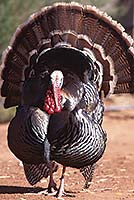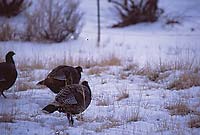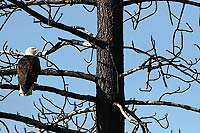Archaeological evidence exists that prehistoric Native Americans in southern Utah domesticated turkeys for their feathers and food by 200 B.C. Turkey feather robes and blankets, bone whistles, prayer feathers, and rock art images attest to this connection. One famous dwelling - Turkey Pen Ruin, has a remnant pen that may have kept birds in a “domesticated situation.” 
Current populations of wild turkeys in southern Utah can trace their lineage to reintroductions. The Rio Grande subspecies was introduced in 1984 and the Merriam’s subspecies was reintroduced in 1952. The two subspecies are similar in appearance; the Rio Grande has tan-colored feather tips, whereas the Merriam’s feather tips are white. Merriam’s turkeys were historically native in Utah, whereas the Rio Grande birds stretched from the Great Plains to northeastern Mexico. Another subspecies, Gould’s wild turkey, occurred in southwestern New Mexico and southeastern Arizona.
Adult male turkeys, known as toms or gobblers, are larger than females and average 17-21 pounds. In contrast, females average 8-10 pounds and are smaller than males. Males have an impressive array of tail feathers that fan out in a near circular pattern when the birds are displaying or during territorial interactions.
Turkeys breed in the spring. Females, called hens, lay an average of 10-12 buff-colored eggs in a ground nest that they construct under cover. Successful incubation takes about 28 days, done solely by the female. Because her nest is on the ground, the female and eggs are at risk from ground predators such as coyotes, foxes, bobcats, and other predators. The female doesn’t initiate incubation until all her eggs are laid, so that when the eggs hatch simultaneously, the young all leave the nest soon after hatching. 
The young, called poults, will follow and forage on insects and larvae with the female. It takes about 10-14 days for their feathers to develop so that the poults can fly short distances. Though adult turkeys seem too large to fly, they can fly up into trees in search of nuts or berries or to roost at night. When I was watching bald eagle nests for the BLM along the Colorado River, I’d often see turkeys roosting in the same large cottonwood tree that held an active bald eagle nest. Neither seemed to mind their neighbors.
In November, flocks of wild turkeys may be observed foraging in fields, woodlands, or along the canyon bottoms for seeds, nuts, berries, insects, invertebrates, buds, waste grain, and just about anything edible. Their powerful gizzards can grind up shells, but they will digest grit to aid in the grinding process.
 It is interesting to note that early European explorers to the New World brought wild turkeys back with them to Europe. The bird’s popularity as poultry grew and spread rapidly across Europe. So much, that when the early colonists reached the New World they had turkeys on board their ships.
It is interesting to note that early European explorers to the New World brought wild turkeys back with them to Europe. The bird’s popularity as poultry grew and spread rapidly across Europe. So much, that when the early colonists reached the New World they had turkeys on board their ships.
If any month heralds the turkey, it is certainly November. Though turkeys may not have been part of the original Thanksgiving meal, they are now the centerpiece of this holiday. We can thank those early reintroductions that brought these wild and wily birds back into their ancestral lands.